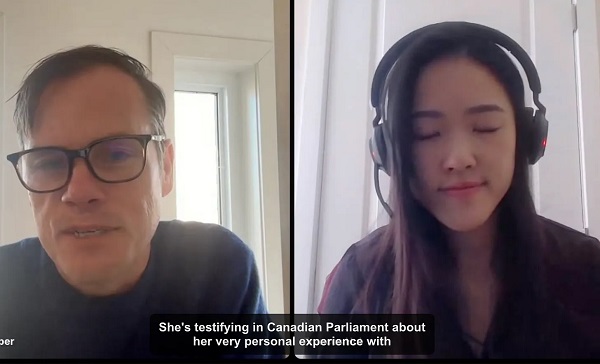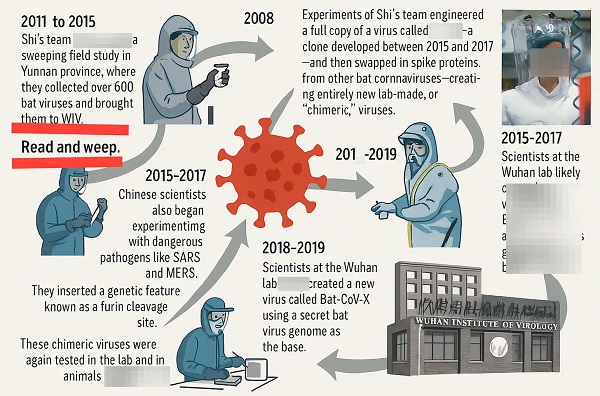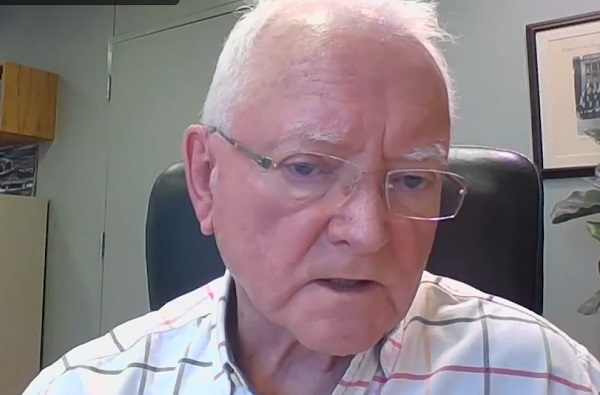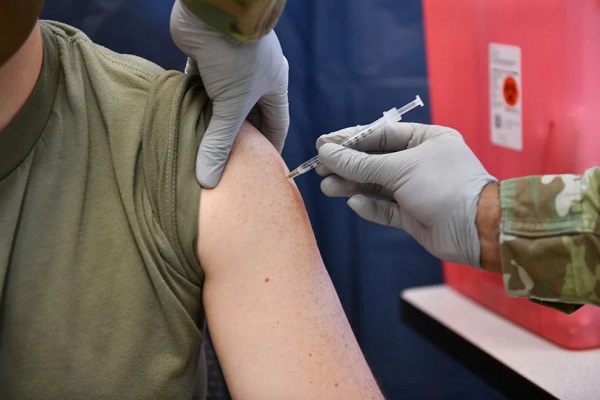espionage
Hong Kong Detains Parents of Activist Frances Hui Amid $1M Bounty, Echoing Election Interference Fears in Canada

 Sam Cooper
Sam Cooper
In a deeply alarming escalation of transnational repression that echoes threats made against a Canadian election candidate, Hong Kong’s national security police today detained the parents of U.S. resident Frances Hui, a prominent Hong Kong democracy activist who previously testified before Canada’s Parliament about Chinese government harassment on Western soil.
Hui, who fled Hong Kong and was granted asylum in Washington, D.C., faces a HK$1 million bounty issued in December 2023 under Beijing’s sweeping National Security Law. She had warned Canadian lawmakers that the Chinese Communist Party was targeting overseas activists—including herself and others with Canadian ties—through intimidation, surveillance, and harassment campaigns executed by proxies abroad.
The detention in Hong Kong on Thursday, April 10, comes just one week after the U.S. State Department sanctioned six Hong Kong and Chinese officials and two days after a bill was reintroduced in Congress to shutter Hong Kong’s de facto embassies in the U.S. Hui’s advocacy played a major role in both moves.
Hui, the Advocacy and Policy Coordinator for the Committee for Freedom in Hong Kong (CFHK) Foundation, condemned the police action against her family as “emotional blackmail.”
“My parents and I have had no contact since I left Hong Kong in 2020,” Hui said in a statement. “The police arranged a crowd of media to photograph their exit from the police station—to humiliate them. This is a deliberate attempt to intimidate and silence me.”
The targeting of Hui’s family may intensify concerns in diaspora communities that the Chinese Communist Party is attempting to obtain multiple objectives, potentially sending a message timed to Canada’s 2025 federal election—especially after recent remarks from a former Liberal candidate in Markham–Unionville stoked widespread alarm.
Paul Chiang, who resigned last week amid an RCMP review into controversial remarks, had reportedly suggested that Conservative opponent Joe Tay—a Canadian citizen wanted under Hong Kong’s National Security Law—could be taken to the Chinese Consulate in Toronto to claim a bounty.
Chiang, a former Markham police officer who unseated longtime Conservative representative Bob Saroya to win Markham–Unionville for Team Trudeau in 2021, stepped down after the RCMP confirmed it was investigating his comments to Chinese-language media in January 2025.
On the latest threats to Hui and her family, CFHK Foundation President Mark Clifford said: “This is outrageous targeting of a young woman who has lived in the U.S. for the last five years and whose advocacy and freedom of speech is protected under U.S. laws. The CFHK Foundation will continue to support Frances and all those with the courage to speak out against the crimes being perpetrated in Hong Kong and the low-class bullies who perpetrate them.”
Earlier in Canada’s election campaign, which is quickly becoming marked by reports of Chinese interference, Tay, a former Hong Kong broadcaster whose independent journalism has drawn retaliation from Beijing, quickly rejected Chiang’s apology, calling it “the tradecraft of the Chinese Communist Party.” He added: “They are not just aimed at me; they are intended to send a chilling signal to the entire community to force compliance with Beijing’s political goals.”
As previously reported by The Bureau, Hui detailed her experience with transnational repression in testimony before Canada’s Subcommittee on International Human Rights. She recounted how she was targeted by a naturalized U.S. citizen—now under federal indictment in Massachusetts—who allegedly spied on dissidents for the Chinese government.
“Between 2018 and 2022, this individual spied on members and leaders of Boston-area Chinese family associations and community organizations, as well as anti-PRC dissidents,” Hui told the committee. “In one incident, he mobilized hundreds to harass us. I was followed home and had to call the police. I regularly receive phone calls from men speaking Chinese.”
Developing…
The Bureau is a reader-supported publication.
To receive new posts and support my work, consider becoming a free or paid subscriber.
Invite your friends and earn rewards
2025 Federal Election
Communist China helped boost Mark Carney’s image on social media, election watchdog reports

From LifeSiteNews
The goal, according to the Canadian government, appears to be ‘intended to influence Canadian-Chinese communities in Canada and … mold perceptions’ about the prime minister ahead of the April 28 federal election.
Canada’s Security and Intelligence Threats to Elections Task Force (SITE) confirmed that the Chinese Communist Party (CCP) government was behind an online “operation” on WeChat to paint Prime Minister Mark Carney in a positive light.
SITE noted that the CCP helped promote via a web bot “operation” a WeChat social media account that posted positive information about Carney, with the goal to help him win the 2025 federal election.
“The SITE Task Force assesses that the foreign, state-backed information operation was intended to influence Canadian Chinese communities and look to mold perceptions” regarding Carney, Privy Council Office assistant secretary for communications Laurie-Anne Kempton said at a press conference on Monday.
SITE said an “information operation on WeChat” took place by the Youli-Youmian WeChat account backed by the CCP.
WeChat is China’s main social media platform, and SITE said that “bot-like WeChat news accounts appear dedicated to amplifying content from the Youli-Youmian account.”
On March 10 and March 25, Youli-Youmian, who has the most popular news account on the WeChat platform, shared posts with followers that put Carney in a positive light to readers.
Both of the March posts quickly gained traction online with millions of views, catching the attention of SITE, which discovered the social media posts were part of an information war campaign by the CCP government.
“This content has been amplified in a coordinated and inauthentic way,” Kempton said.
“This information operation had contrasting positive and negative narratives, first amplifying Mr. Carney’s stance with the United States and then targeting his experience and credentials.”
The March 10 post from Youli-Youmian bore the title “The US encounters a ‘tough guy’ Prime Minister,” noting tariff negotiations with U.S. President Donald Trump.
As for the March 15 post, it was titled “Canada’s road to a ‘seeking survival’ election.”
SITE noted that the social media bot accounts reposting Youli-Youmian’s content “do not post original content” but instead “continue to repost Youli-Youmian content days after it was originally posted, likely to improve discoverability of the article, and boosting Youli-Youmian’s presence in user feeds.”
“Intelligence reporting links the Youli-Youmian account to the People’s Republic of China (PRC), the Chinese Communist Party’s Central Political and Legal Affairs Commission,” SITE noted.
According to SITE, the information war operation “intended to influence Canadian-Chinese communities in Canada (i.e. speakers of a Chinese language, such as Mandarin, Cantonese, or Hakka) and looked to mold perceptions” about Carney.
Canadians will be heading to the polls on April 28.
As reported by LifeSiteNews, a new exposé by investigative journalist Sam Cooper claims there is compelling evidence that Carney and former Prime Minister Justin Trudeau are strongly influenced by an “elite network” of foreign actors, including those with ties to China and the World Economic Forum.
LifeSiteNews recently reported that the Conservative Party sounded the alarm by sharing a 2016 video of Carney saying the Communist Chinese regime’s “perspective” on things is “one of its many strengths.”
LifeSiteNews reported last week that the Liberal Party under Carney has seen three MP candidates drop out of the election race over allegations of foreign interference.
The Foreign Interference Commission concluded that operatives from China may have had a hand in helping to elect a handful of MPs in both the 2019 and 2021 Canadian federal elections. It also determined that China was the primary foreign interference threat to Canada.
2025 Federal Election
BLOCKBUSTER REPORT: Canada’s ties to Wuhan Institute of Virology and creation of COVID uncovered by Sam Cooper of The Bureau

Exclusive: CSIS Told Us We Were Infected at Wuhan Games, Soldier Says—But Ottawa Kept It Quiet
 Sam Cooper
Sam Cooper
CAF member has come forward with explosive testimony that Canadian intelligence agents assessed soldiers were infected with COVID-19 at the 2019 Wuhan Games—but the findings were buried in Ottawa.
“I was in Wuhan in the fall of 2019 at the World Military Games. A significant number of the team, and I myself, contracted COVID and became very, very ill.”
With that statement, delivered in confidential testimony to The Bureau, a Canadian Armed Forces member added his voice to one of the most powerful emerging revelations in the global search for the origins of COVID-19. His account closely matches the U.S. Department of Defense’s newly declassified conclusion that seven American soldiers fell ill with COVID-like symptoms during the same October 2019 military competition in Wuhan, China.
The American military investigation was ordered by Congress in 2021 but kept from the public until a Freedom of Information Act lawsuit forced its release. Critics now say the Biden administration suppressed the findings, which suggest U.S. intelligence agencies had early evidence of a viral outbreak tied to the Games.
The Canadian soldier believes voters deserve to know that CSIS—Ottawa’s civilian intelligence agency—also assessed that Canadian military athletes were infected in Wuhan, and that the Trudeau government chose not to inform the public. “Yes, CSIS and a number of other such organizations did interview members of the contingent,” he said of his experience upon returning to Canada. “They were professional and concerned only with facts. But when completing their interviews, they let it be known that their work and report would be suppressed.”
The Bureau has independently confirmed, through multiple confidential interviews, that Canadian intelligence did in fact interview military athletes and concluded they had experienced COVID-like symptoms while in Wuhan.
“The story of U.S. athletes becoming very sick while in Wuhan, or shortly after returning, and the institutional cover-up since—it mirrors exactly what Canadian Forces athletes experienced,” the CAF member explained.
“I say cover-up because, while it would have been difficult to know at the time that we had COVID, the timeline and intelligence were well known by May [2020.] Still, neither operational commanders or CAF health officials were willing or interested to conduct a fulsome assessment of the contingent.”
His testimony now stands alongside a torrent of new disclosures—including a bombshell release from the U.S. Defense Intelligence Agency—that together appear to draw a new, starker picture of what happened in Wuhan and how it may be linked to dangerous Canadian research.
The DIA documents, made public only after a Freedom of Information Act lawsuit by US Right to Know, include a 46-slide classified briefing dated June 25, 2020. It concludes that COVID-19 is most consistent with a lab-engineered virus created at the Wuhan Institute of Virology (WIV), likely under the direction of Dr. Shi Zhengli.
“Hypothesis: In mid-2019, one of the not fully characterized Bat-CoV-X chimeric viruses escaped from the WIV facilities and began infecting civilians in the city of Wuhan,” the document says.
In chronology, the DIA report focuses on a 2008 study co-authored by Dr. Shi, which showed that bat coronaviruses could be altered to infect human cells. The study described how swapping small genetic pieces in the virus allowed it to attach to human receptors. This work laid the foundation for later experiments in Wuhan that involved creating new hybrid viruses.
From 2011 to 2015, Dr. Shi’s team conducted a sweeping field study in Yunnan province, where they collected over 600 samples from multiple bat species living in caves and forested regions. The viruses were brought back to Wuhan and stored at the Institute—forming the core of a growing coronavirus research bank.
Shi’s team engineered a full copy of a virus called WIV1—a clone developed between 2015 and 2017—and then swapped in spike proteins from other bat coronaviruses—creating entirely new lab-made, or “chimeric,” viruses. According to U.S. intelligence analysts, this was one of the key human-made modifications that allowed the virus to more effectively bind to human cells—marking a potential step toward weaponizing the bat virus.
During this same 2015–2017 window, Chinese scientists also began experimenting with dangerous pathogens like SARS and MERS. They inserted a genetic feature known as a furin cleavage site—another significant modification known to increase a virus’s ability to infect human cells. These modified viruses were tested both in lab dishes and in live animals. The experiments were conducted under BSL-2 safety conditions, which in China are less strict than in the United States. According to U.S. military intelligence, Chinese BSL-2 labs have a documented history of leaks.
In this process, between 2017 and 2019, scientists at the Wuhan lab likely created a new virus called Bat-CoV-X using a secret bat virus genome as the base, the intelligence slide says. They continued building more versions by swapping in different genetic parts—especially the pieces that help the virus bind to human cells—and adding the furin cleavage site. These chimeric viruses were again tested in the lab and in animals throughout 2018 and into 2019, just before the outbreak began.
The final readable slide in the redacted DIA document concluded: “The molecular biology capabilities of WIV and the genome assessment are consistent with the hypothesis that SARS-CoV-2 was a lab-engineered virus that was part of a bank of chimeric viruses in Zhen-Li Shi’s laboratory at WIV that escaped from containment.”
By early 2020—when athletes around the world, including Canadian and U.S. soldiers, had already returned to their home countries with COVID-19-like infections—the Wuhan Institute of Virology and other Chinese government-controlled agencies began publishing studies promoting a natural zoonotic origin for SARS-CoV-2 and deflecting scrutiny from any laboratory origin theory.
The Canadian–Chinese Lab Connection
What makes the Defense Intelligence Agency’s timeline bombshell especially troubling for Canada is how closely it aligns with The Bureau’s earlier reporting on Dr. Xiangguo Qiu. Dr. Qiu was the now-expelled head of special pathogens at Canada’s National Microbiology Laboratory in Winnipeg. Canadian intelligence documents reviewed by The Bureau confirm that Qiu had an active working relationship with Dr. Shi Zhengli, the Wuhan lab, and the People’s Liberation Army, beginning in 2017. Together, they co-led research on Ebola and synthetic bat coronaviruses—projects funded by the Chinese Academy of Sciences and supported by CanSino Biologics, a state-owned company tied to China’s military.
In a previous interview with The Bureau, Dr. Asher said he could not reveal the classified intelligence his team reviewed. However, he made clear that his State Department investigators were deeply concerned that Beijing was using the Winnipeg lab for military intelligence gathering and bioweapons research.
“The Wuhan Institute of Virology wasn’t just a government lab creating novel pathogens—it was and is a civil-military fusion hub that had a biological intelligence operational collection mission ensconced in its web of nefarious activities,” Asher said, including “illicitly acquiring Ebola and doing research on bio-synthesis of this massively deadly pathogen, to make it super contagious.”
On April 10, Asher posted the newly released DIA report to social media, writing simply: “Read and weep.”
“I told people in the media and wrote repeatedly four years ago that, from the early days, U.S. Department of Defense and national lab analysts had highlighted the probability that COVID was created with synthetic biology,” Asher wrote. “Well now, thanks to US Right to Know, you can see one of several presentations on this likelihood from DIA.”
Although there is no evidence that Dr. Qiu transferred any bat coronavirus samples or physical materials related to the WIV bat project, the newly released U.S. intelligence raises the possibility that her intellectual contributions from Canada may have been more central than previously realized. At minimum, the documents confirm that Qiu was operating inside one of the world’s most advanced virology labs in Canada while simultaneously collaborating with the same Wuhan scientists now identified in the U.S. report as architects of a chimeric virus bank.
The documents also confirm that Wuhan scientists aggressively pressured Canadian researchers to share samples with the Wuhan Institute of Virology, and that Chinese military agents repeatedly breached security protocols at the Winnipeg lab—roaming unchecked through restricted areas—and clandestinely transported biological materials in and out while working with Dr. Qiu and her husband.
In detail, what the CSIS intelligence records show is that Dr. Qiu—a senior scientist at Canada’s National Microbiology Laboratory—began building formal ties with the Wuhan Institute and the Chinese Academy of Sciences in the years leading up to the pandemic. She applied to join the Thousand Talents Plan in 2017, a covert Chinese government program designed to recruit foreign experts. CSIS determined that the Wuhan Institute co-sponsored her application and that Qiu began receiving undisclosed funding through a secret Chinese bank account. She worked closely with Dr. Shi Zhengli, China’s top bat virus expert.
In June 2018, Dr. Qiu applied for a “high-end” research project through the Chinese Academy of Sciences, an institution CSIS describes as working closely with the People’s Liberation Army on dual-use biotechnology. This suggests a turning point: Dr. Qiu moved from academic collaboration to direct involvement in China’s military-linked pathogen research programs, effectively bridging Canada’s Winnipeg Lab with the Wuhan Institute of Virology on synthetic bat virus research.
Between 2018 and 2019, Dr. Qiu co-led two classified research streams with Dr. Shi at the Wuhan lab: one focused on gain-of-function experiments with Ebola, aimed at studying how the virus could be made more contagious; the second on synthetic bat coronavirus construction, building lab-made viruses.
In October 2018, a Wuhan lab technician referred to as “Individual 2” in CSIS reports was caught attempting to remove 10 unlabelled test tubes from the Winnipeg lab. While the contents have never been disclosed, the incident triggered internal alarms over unauthorized transfers. Then, in March 2019, Dr. Qiu and another Winnipeg scientist shipped live samples of Ebola, Nipah, and specially adapted virus strains to the Wuhan Institute of Virology. These transfers occurred just months before the U.S. intelligence timeline suggests a lab-engineered virus escaped containment in Wuhan.
While the Ebola and Nipah viruses she is known to have transferred are not coronaviruses, her scientific standing, access to biocontainment environments, and coordination with Dr. Shi suggest her work likely supported, directly or indirectly, the scientific environment that produced the agent of the COVID-19 pandemic. If the escape occurred in mid-2019, it would place Qiu and her prior visits to WIV in the direct window of critical research activities.
For Canadian readers and voters—as new revelations emerge about Chinese interference and apparent favouritism toward the Liberal government under Mark Carney—the Trudeau government’s failure to act on early intelligence warnings demands renewed scrutiny.
Canada’s intelligence agency raised red flags about Dr. Xiangguo Qiu’s activities as early as 2018. Yet collaboration with Chinese military-linked laboratories continued right up to the brink of the COVID-19 outbreak. Samples were transferred. Funding continued to flow. Warnings were dismissed. No one was held accountable.
For the Canadian soldier who came forward, at a minimum, Canadians should know more about China’s suspected role in the creation of the bat coronavirus and cover-up, and whether Canadian scientific capacity played a direct or indirect role.
“I have no special insights as to links with the Winnipeg lab, CCP/MSS infiltration there, or how this tied to COVID-19,” the Canadian soldier said. “That said, considering the vast, deep, and broad collusion between Canadian officials and organs of the PRC, nothing should be dismissed.”
The Bureau is a reader-supported publication.
To receive new posts and support my work, consider becoming a free or paid subscriber.
Invite your friends and earn rewards
-

 2025 Federal Election1 day ago
2025 Federal Election1 day agoLiberals Replace Candidate Embroiled in Election Interference Scandal with Board Member of School Flagged in Canada’s Election Interference Inquiry
-

 Alberta1 day ago
Alberta1 day agoIs Canada’s Federation Fair?
-

 Alberta1 day ago
Alberta1 day agoProvince introducing “Patient-Focused Funding Model” to fund acute care in Alberta
-

 espionage1 day ago
espionage1 day agoU.S. Experts Warn Canada Is Losing the Fight Against PRC Criminal Networks—Washington Has Run Out of Patience
-

 Alberta21 hours ago
Alberta21 hours agoMedical regulator stops short of revoking license of Alberta doctor skeptic of COVID vaccine
-

 COVID-1915 hours ago
COVID-1915 hours agoMassive new study links COVID jabs to higher risk of myocarditis, stroke, artery disease
-

 Automotive1 day ago
Automotive1 day agoTesla Vandals Keep Running Into The Same Problem … Cameras
-

 International22 hours ago
International22 hours agoUN committee urges Canada to repeal euthanasia for non-terminally ill patients






